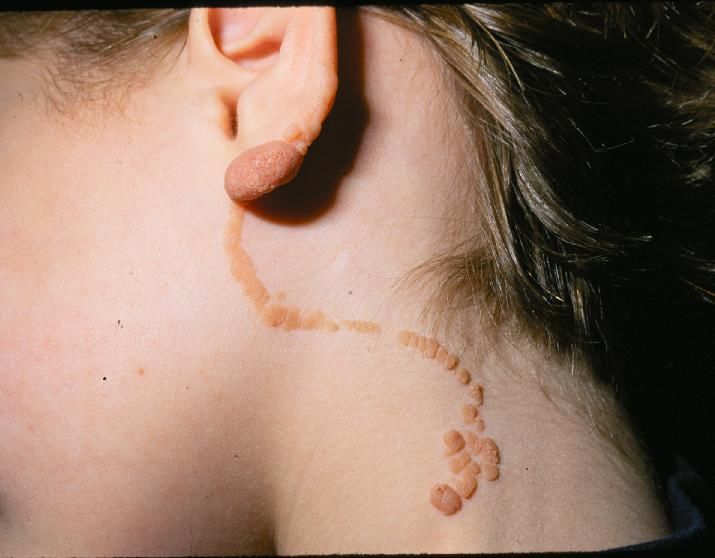EPIDERMAL NEVUS SYNDROME

Definition: Epidermal Nevus Syndrome is a rare disorder characterized by distinctive birthmarks (nevus) on the skin. Neurological and skeletal abnormalities may also occur. This disorder is usually apparent at birth (due to the skin lesions which are most often seen in the midface from the forehead down into the nasal area) and is often associated with seizures, mental deficiency, eye problems, bone malformations and atrophy of the brain. [4]
Epidermal Nevus Syndrome was first described in 1968. It is a multisystem disease with potentially devastating consequences. Most cases are sporadic though occasional cases of autosomal dominant transmission have been documented. [4]
Since the syndrome’s first description, a broader concept for the “epidermal nevus” syndrome has been proposed, with at least six types being described. These are:
- Schimmelpenning syndrome
- Nevus comedonicus syndrome
- Pigmented hairy epidermal nevus syndrome
- Proteus syndrome
- CHILD syndrome
- Phakomatosis pigmentokeratotica [2]
Other Names: Feuerstein and Mims syndrome [1] Solomon syndrome [3]
Causes
The exact cause of Epidermal Nevus Syndrome is not known although an autosomal dominant trait of inheritance seems to occur in approximately two thirds of the cases. [4]
Treatment
Therapy is often challenging.
Epidermal nevi are usually resistant to topical and intralesional steroids, dithranol, topical retinoids, and cryosurgery. Topical calcipotriol may be effective. In the United States, calcipotriol is not approved for children younger than 12 years. If the size and the site are suitable, the nevus may be excised if desired by the patient. [5]
No ideal medical therapy for the cutaneous lesions of epidermal nevus syndrome exists. The vitamin D analogue calcipotriol may be tried in each form of this disease, particularly inflammatory linear verrucous epidermal nevus. This substance is a synthetic vitamin D-3 analog that regulates skin cell production and development. It inhibits epidermal proliferation, promotes keratinocyte differentiation, and has immunosuppressive effects on lymphoid cells. Calcipotriol is prescribed as a 0.005% topical ointment. [5]
References
- Freedberg, et al. (2003). Fitzpatrick’s Dermatology in General Medicine. (6th ed.). McGraw-Hill.
- James, William; Berger, Timothy; Elston, Dirk (2005). Andrews’ Diseases of the Skin: Clinical Dermatology. (10th ed.). Saunders.
- http://www.thedoctorsdoctor.com/diseases/epidermalnevus_syndrome.htm#epidemiology
- Rogers M, McCrossin I, Commens C. Epidermal nevi and the epidermal nevus syndrome. A review of 131 cases. J Am Acad Dermatol. Mar 1989;20(3):476-88.


